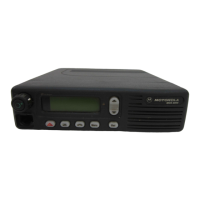December 6, 2004 68P81083C20-D
7-22 Controller Section Theory of Operation: Audio and Signalling Circuits
Figure 7-4. Receive Audio Paths
The audio path has a programmable amplifier, whose setting is based on the channel bandwidth
being received, then a LPF filter to remove any frequency components above 3000 Hz and then an
HPF to strip off any sub-audible data below 300 Hz. Next, the recovered audio passes through a de-
emphasis filter if it is enabled (to compensate for Pre-emphasis which is used to reduce the effects of
FM noise). The IC then passes the audio through the 8-bit programmable attenuator whose level is
set depending on the value of the volume control. Finally the filtered audio signal passes through an
output buffer within the ASFIC. The audio signal exits the ASFIC at RX AUDIO (U0200-J4).
The µP programs the attenuator, using the SPI BUS, based on SB9600 messages from the control
head. The minimum /maximum settings of the attenuator are set by codeplug parameters.
J403
12
11
25
3
1
2
FILTERED AUDIO
UNIV IO OUT
EXTERNAL
SPEAKER
INTERNAL
SPEAKER
ACCESSORY
CONNECTOR
CONTROL
HEAD
CONNECTOR
AUX RX
HANDSET
AUDIO
8
2
1
J405
INT
SPKR+
SPKR -
SPKR +
AUDIO
PA
U0203
4
6
1
9
ATTEN.
UNIV
IO
RX AUD
OUT
UNAT
RX OUT
EXP AUD IN
RX IN
PL IN
AUX RX IN
SQ IN
CH
ACT
SQ
DET
ASFIC
U0200
VOLUME
ATTEN.
MICRO
CONTROLLER
HEARCLEAR - I
IC
U0250
EXP
IN
EXP OUT
FF OUT
FFIN
A2
F4
J5
H6
J7
J6
C1
J401
J408
9
10
5
9
10
5
DISC
DISC (GAIN CONTROLLED)
AUX RX
DISC
DISC (GAIN CONTROLLED)
AUX RX
E4
DISC (DISCRIMINATOR AUDIO)
SQUELCH
FROM
RF
SECTION
(ZIF)
H7
H2
H1
J4
B2H5
SQUELCH
CIRCUIT
FILTER AND
DEEMPHASIS
LIMITER, RECTIFIER
FILTER, COMPARATOR
INTERNAL
OPTION
CONNECTORS

